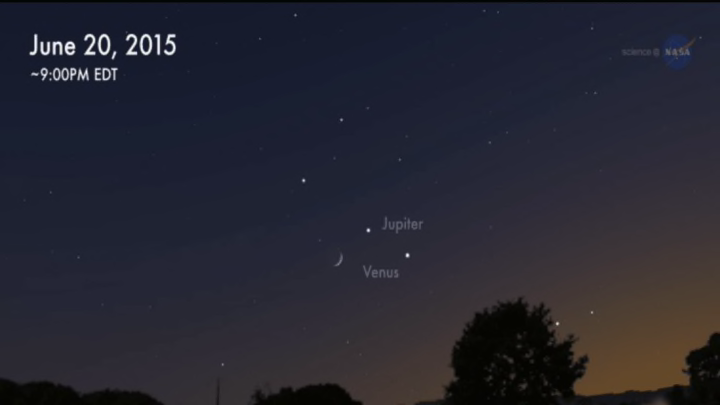Look West Tonight! Venus and Jupiter Are in the Process of "Converging"

If you’re looking to see a fantastic show this month, go outside at sunset and look west. Throughout June, Venus and Jupiter, two of the brightest objects in our sky, are converging. They'll glide closer and closer to each other until they appear to form a single bright glow on the horizon.
Their slow dance started at the beginning of the month, with both planets visible low in the sky at dusk and early evening. On a clear night, you can’t miss them: after the Sun and the moon, Venus and Jupiter are the third and fourth brightest objects in the sky. Tonight, June 20, the planets will be just 6 degrees apart—and things start to get really interesting as they’re joined by the waxing crescent moon to form a celestial triangle.
If you have a telescope, Venus will appear as a waning crescent, and Jupiter will be surrounded by its moons. You’ll also be able to see some of the craters on the surface of our own moon. Even if you don’t have a telescope, looking at this apparent joining of celestial bodies with the naked eye will no doubt be a thing of beauty.
Of course, in reality they’re nowhere near each other—Venus is 67 million miles from the sun and Jupiter is 484 million miles—but from our perspective, they will seem very close for a very short amount of time. On June 30 and July 1, the show culminates as Venus and Jupiter appear just one-third of a degree apart, which is less than the diameter of the moon when it’s full in the sky. They'll be so close, you'll be able to hold up your pinkie finger to the sky and cover both planets at once.
NASA ScienceCasts has a lovely little video about the phenomenon:
The pair will go their separate ways after July 1 when the full moon rises. But keep your eyes on the sky, because July features a second full moon—known as a blue moon—on the 31st. Happy planet gazing!